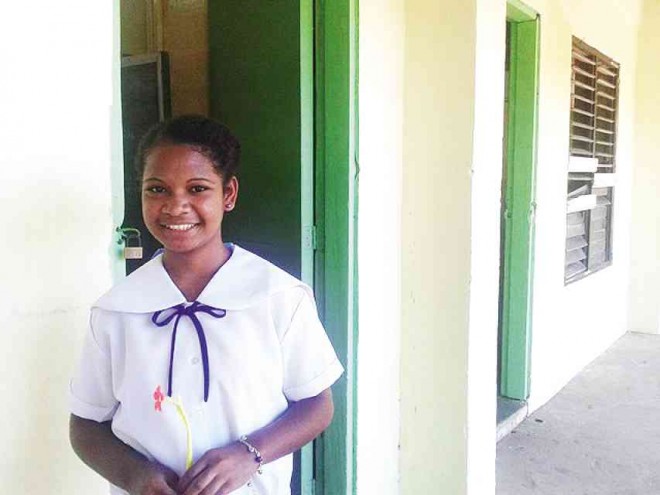For Aetas, no school is too remote for their education

VESY Balario, 15, a Grade 10 Aeta student of Cawag Resettlement High School in Subic, Zambales province, believes that completing her education is her only way of achieving her dream of becoming a teacher.ALLAN MACATUNO/INQUIRER CENTRAL LUZON
SUBIC, Zambales—Vesy Balario, 15, imagines herself teaching children in remote places. As an Aeta, she believes that completing her education is the only way of achieving this goal.
Now in Grade 10 at Cawag Resettlement High School (CRHS) in Barangay Cawag here, Balario is still holding on to that dream, hurdling poverty and discrimination.
“It’s my dream to become a teacher to Aeta children,” she said.
But going to school has never been easy, especially for children belonging to indigenous peoples groups in Zambales.
“I’m determined to finish my studies because through it I’ll be able to repay the sacrifices of my parents,” Balario said.
Article continues after this advertisementHouse chores
Article continues after this advertisementShe said she has to wash her only pair of uniform every night so she can wear it the following day. “Most of the time, I go to my class with my uniform still slightly wet,” she said.
Balario’s father is a contractual worker at a Korean ship-building company here while her mother stays at home.
As the oldest of two siblings, Balario said she has to help her mother sell vegetables during her free time to earn extra for the family.
During school days, she said her parents would give her a P10-allowance, but most of the time she goes to her classes with an empty stomach.
“I learned to be thrifty and spend my allowance on things I only need. It’s tough but it’s a reality that I have learned to accept,” she said.
Balario has also learned to overcome discrimination. Other students would call her names because of her dark skin and kinky hair.
“They would make fun of how I look but I’ve learned to ignore them. I don’t take them seriously,” she said.
Grade 10 student Juvelyn Rivera, 16, shares an almost similar experience as an Aeta student.
Like Balario, she also dreams of finishing school and becoming a teacher.
30-minute walk
“I’m very proud to be an Aeta and I’ll prove to others that even if we’re poor we can still reach our dreams,” she said.
Rivera, who walks about 30 minutes from their home to school, would also brave heavy downpour to attend her classes during the rainy season.
“Nothing will hinder me from achieving my dreams and that’s what I want to show to other Aeta children who want to be successful someday,” Rivera said.
In nearby Cawag Resettlement Elementary School (CRES), cousins Abijim Ablong, 11, and Princess Cabalic, 10, are also striving to finish school.
Both in Grade 6, the Aeta pupils also walk to school every day and attend classes despite lacking notebooks, pencils and other school items.
Despite these problems, they are doing well in school. Ablong is a consistent honor student while Cabalic is the president of their school’s Supreme Pupil Government.
“I’m studying hard to help my parents in the future. I would like to give them a decent life,” Ablong said.
Another Grade 6 pupil, Jonaliza Linggay, 12, said she dreams of becoming a nurse someday so her parents, who are unemployed, can be proud of her.
“I want to help my parents and our community as well. If I become a nurse, I will be able to help the sick,” Linggay said.
June Asuncion, CRES principal, said the school has 72 Aeta children and most live at least 2 kilometers away from the campus.
“Our Aeta students are really striving to be educated and many of them walk their way to school every day,” Asuncion said.
Jimmy Ablong, Aeta tribal chieftain of Barangay Cawag, said at least 100 Aeta families live in the village. “Many of the indigenous peoples here are trying to send their children to school. But due to financial constraints, many of them have failed to even reach high school,” Ablong said.
Mary Meana, CRHS principal, also cited cases of early marriage as a major reason some students fail to finish school. She said their school has been supportive of Aeta children but they need help to repair classrooms so these will be more conducive for learning.